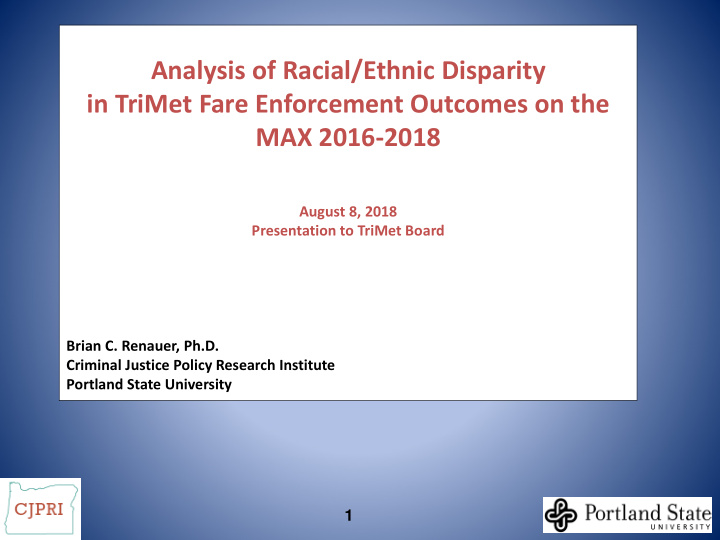



Trend Analysis: Analysis of Racial/Ethnic Disparity in TriMet Fare Enforcement Outcomes on the MAX 2016-2018 August 8, 2018 Presentation to TriMet Board Brian C. Renauer, Ph.D. Criminal Justice Policy Research Institute Portland State University 1
Research Questions & Terms Key Goals: 1. Follow-up to the 2014-2016 study. Using the most recent 2 years of data March 2016 to 2018. 2. Used the same methodology involving the fare evasion survey as the racial/ethnic baseline of the likelihood of being involved in a fare evasion incident. 3. Some new analyses focusing on individuals Key Terms : Disparity = differences in enforcement outcomes between racial/ethnic groups of riders based on an expectation of each group ’ s likelihood of receiving a warning, citation, or exclusion. 2
Guiding Principles to Research 1. Looking for patterns in fare enforcement data that indicate thresholds large enough to determine if disparities between racial/ethnic groups are unlikely due to random statistical or measurement issues. 2. If a threshold in disparity is reached it is considered noteworthy and could signify systemic causes within organizational policy, practices, enforcement officers, or ridership demographics is causing the pattern, including racial bias or profiling. 3. A more thorough investigation of the issue is then warranted. 4. If a threshold is not reached, that doesn’t mean an agency should be any less vigilant to ensure equitable enforcement practices or concerned that hidden biases may exist. 3
Data Data: 48,060 fare enforcement incidents on the MAX from March 2016 to March 2018. Baseline for likelihood of being in a fare evasion incident: • Racial/ethnic average of the 2016 to 2018 Fare Evasion Surveys 4
Fare Evasion Incidents 2014-16 Compared to 2016-18 5
Fare Evasion Incidents 2014-16 Compared to 2016-18 • Conclusion 1 = Declines in total enforcement incidents (9.3%), citations, warnings, and exclusions. Exclusions are down 20%. Declines occurred roughly equally for all racial/ethnic groups. • Conclusion 2 = Marked change in the proportion of riders classified as as “ unknown ” race/ethnicity (970 incidents to 2,706). Understanding this increase is important. Appears to be driven by a small number of inspectors. 6
Baseline Test # 1: Results Conclusion 3 = Differences between the fare evasion survey results and enforcement outcomes are small and indicate little disparity. Differences are all below the 5% threshold . African American exclusions are elevated, but below threshold and lower than 2016 report. 7
Repeat Offending Conclusion 4 = Repeat fare evasion is still a unique challenge and remains more pronounced among African American riders . 8
Chronic Exclusions and Fare Evasion Conclusion 5 = Elevated exclusion rates for African Americans is more likely an issue with a small population of riders engaging in chronic fare evasion and receiving multiple exclusions and less likely the result of systemic racial/ethnic biases in enforcement. The presence of a small group of riders with chronic exclusions is also prevalent among White riders. 9
Exclusions by Sub-Type Conclusion 6 = Not much racial/ethnic variation in exclusion sub-types. 10
Geographic Variation Conclusion 7 = Not much racial/ethnic variation in stop locations. 11
Baseline Test # 2 – Logistic Regression Conclusion 8 = Impact of race/ethnicity of rider is not a significant predictor of differentiating who receives a citation vs. warning, or citation vs. exclusion. 12
Final Thoughts Conclusion 9 = The question of how to address the population of chronic fare evaders and exclusion recipients, particularly those that become known “regulars”, forms an important policy discussion. Continued citations and exclusions alone does not appear to address the issue. 13
THANK YOU QUESTIONS 14
Recommend
More recommend